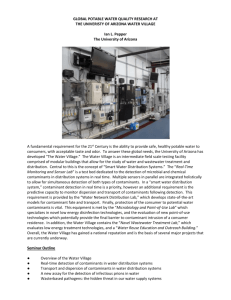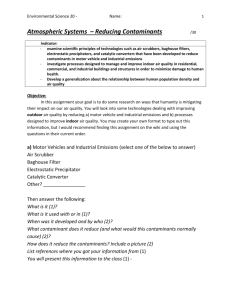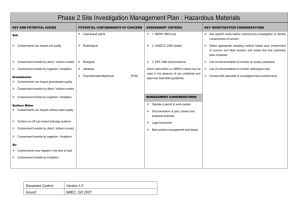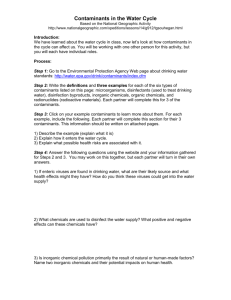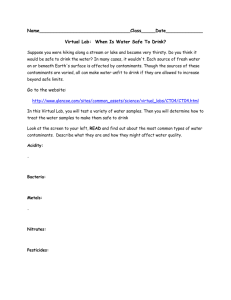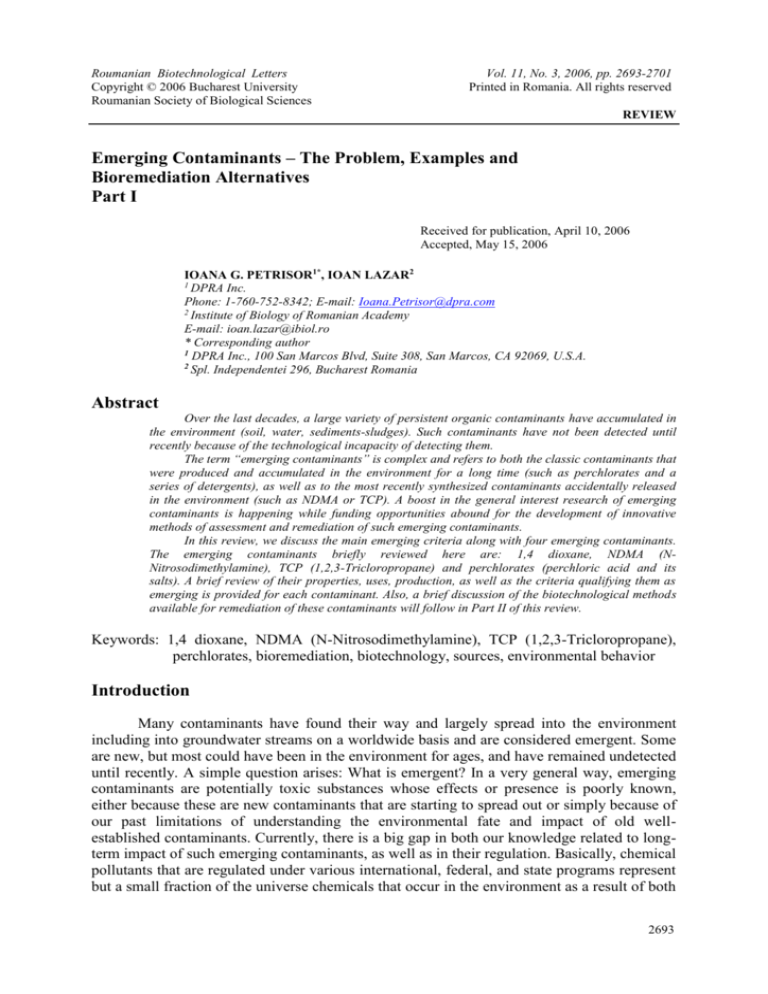
Roumanian Biotechnological Letters
Copyright © 2006 Bucharest University
Roumanian Society of Biological Sciences
Vol. 11, No. 3, 2006, pp. 2693-2701
Printed in Romania. All rights reserved
REVIEW
Emerging Contaminants – The Problem, Examples and
Bioremediation Alternatives
Part I
Received for publication, April 10, 2006
Accepted, May 15, 2006
IOANA G. PETRISOR1*, IOAN LAZAR2
1
DPRA Inc.
Phone: 1-760-752-8342; E-mail: Ioana.Petrisor@dpra.com
2
Institute of Biology of Romanian Academy
E-mail: ioan.lazar@ibiol.ro
* Corresponding author
1
DPRA Inc., 100 San Marcos Blvd, Suite 308, San Marcos, CA 92069, U.S.A.
2
Spl. Independentei 296, Bucharest Romania
Abstract
Over the last decades, a large variety of persistent organic contaminants have accumulated in
the environment (soil, water, sediments-sludges). Such contaminants have not been detected until
recently because of the technological incapacity of detecting them.
The term “emerging contaminants” is complex and refers to both the classic contaminants that
were produced and accumulated in the environment for a long time (such as perchlorates and a
series of detergents), as well as to the most recently synthesized contaminants accidentally released
in the environment (such as NDMA or TCP). A boost in the general interest research of emerging
contaminants is happening while funding opportunities abound for the development of innovative
methods of assessment and remediation of such emerging contaminants.
In this review, we discuss the main emerging criteria along with four emerging contaminants.
The emerging contaminants briefly reviewed here are: 1,4 dioxane, NDMA (NNitrosodimethylamine), TCP (1,2,3-Tricloropropane) and perchlorates (perchloric acid and its
salts). A brief review of their properties, uses, production, as well as the criteria qualifying them as
emerging is provided for each contaminant. Also, a brief discussion of the biotechnological methods
available for remediation of these contaminants will follow in Part II of this review.
Keywords: 1,4 dioxane, NDMA (N-Nitrosodimethylamine), TCP (1,2,3-Tricloropropane),
perchlorates, bioremediation, biotechnology, sources, environmental behavior
Introduction
Many contaminants have found their way and largely spread into the environment
including into groundwater streams on a worldwide basis and are considered emergent. Some
are new, but most could have been in the environment for ages, and have remained undetected
until recently. A simple question arises: What is emergent? In a very general way, emerging
contaminants are potentially toxic substances whose effects or presence is poorly known,
either because these are new contaminants that are starting to spread out or simply because of
our past limitations of understanding the environmental fate and impact of old wellestablished contaminants. Currently, there is a big gap in both our knowledge related to longterm impact of such emerging contaminants, as well as in their regulation. Basically, chemical
pollutants that are regulated under various international, federal, and state programs represent
but a small fraction of the universe chemicals that occur in the environment as a result of both
2693
IOANA G. PETRISOR, IOAN LAZAR
natural processes and human influence [1]. In the U.S., only very few pollutants are regulated.
These are known as “priority pollutants”. Yet, the potential risk from the unregulated
chemicals exists and recent advances in science and technology have resulted in our
awareness and understanding of such risks. It is of major importance to establish the basis
(criteria) of understanding how a chemical could become harmful, how we can determine this
and classify a contaminant as emergent.
This review will start by pointing out some criteria that may classify a contaminant or
contamination event as emergent, with the understanding that there may be many other
aspects to be identified and discussed in future work. The main purpose of this review is to
share information on four out of eight emerging contaminants of environmental concern.
Three of these compounds (1,4 dioxane, N-nitrosodimethylamine and 1,2,3-tricholoro
propane) are identified as emerging contaminants by the United States Department of
Defense.
Emerging Contaminant Criteria
Emerging Pollutants vs. Emerging Concerns
There are two main types of emergent contaminants: the new “truly emerging”
pollutants that have just gained entry into the environment (for example because they are new
to commerce) and the old pollutants that have been produced for a long time and for which
new concerns (new aspects of their occurrence, fate, or effects etc.) are currently raised
according to a large variety of criteria discussed in this section. These criteria are all based on
recent data that trigger our awareness and will be discussed further. The term “emergent” is
often intended not to refer to the pollutant itself, but rather to a newly hypothesized concern
regarding an old pollutant.
New insights into Persistence, Bioaccumulation and Toxicity
The three traits listed here are usually commonalities that dictated the highest
propensity for adverse effects from chemical stressors [1]. Persistence relates to long
environmental half-lives, thus resisting biodegradation and degradation in general and it is a
measure of the structural stability of a chemical. Bioaccumulation represents bioconcentration
of a certain chemical in a living organism via the food chain and relates to the chemical
propensity for accumulating lipids and fat. Toxicity refers to the capacity of a chemical to
possess acute or chronic toxicity in its own right. These are the main factors to be considered
when establishing the risk that a chemical may pose to humans and the environment. We
know the definition of each of these traits and based on such criteria priority pollutants have
been established and are already regulated.
New Criteria for Assessing Persistence. Yet, it is our assessment of such criteria that may
leave gaps in identifying all the contaminants that may pose a risk. Any of these criteria could
be reassess and generate a new list of possible emergent contaminants [1]. For instance, what
is it that makes a contaminant persistent? Apart from its chemical structural stability, there are
others factors that can make contaminants persistent, such as: a continual release, as in the
case of sewage sludge wastes released continuously into receiving water stream. Thus,
regardless of structural stability, a compound will persist in the environment if it is
2694
Roum. Biotechnol. Lett., Vol. 11, No. 3, 2693-2701 (2006)
Emerging Contaminants – The Problem, Examples and Bioremediation Alternatives. Part I
continuously released. Therefore, each contaminant should be judged and integrated into the
specific environmental conditions.
New Criteria for Assessing Bioaccumulation. The bioaccumulation tendency relates to how
easy a chemical can penetrate through living organisms. If we take a look at the broad picture,
the ability to bind to lipids and fats is only one factor that may facilitate the chemical
accumulation in organisms. Another factor may be the dimension of the particle. This is the
case of nanoparticles. Their small, sub-cellular scale facilitates their entrance and transport
within living cells.
New Criteria for Assessing Toxicity. Here again we can enlarge our understanding of what
makes a compound toxic. If we think in terms of effect (toxicity to humans), several potential
causes may be found, only one of which relates to the toxicity of the compound itself. The
environmental set of conditions related to a certain contaminant release may determine toxic
effects of otherwise not harmful compounds. These compounds may be viewed as indirect
toxicants. For example, there are antibiotics that may elicit adverse outcomes by way of
selecting for pathogen resistance. Nanoparticles represent another example of indirect
toxicants. While not toxic by themselves, when entering the human body, they could impair
cellular function and defense. Another reason for our lack of current identification of all the
toxic compounds may be our methodology of assessing toxicity. Thus, toxicological studies
have usually limited time-frames and the conclusions are related to the harmful effects that a
chemical may induce after a limited period of observation. Well, what about effects that may
appear much later in time, a long time after the exposure has ceased? These will always
escape the classic toxicological studies. An example here of a chemical with potent delayed
onset toxicity is the pyrrolizidine alkaloids [1].
However, there are many other factors that could make a chemical to be of
environmental significance. These factors are related to toxicological data (potential for
cancer, or potential effects by exposure at low levels on a life time basis, or potential
interference and disruption of physiological functions in humans), detection (widespread
detection in environment or human body, or uncontrollable sources), and also to
environmental conditions (including unpredictable mixing effects, interfaces phenomena –
accumulation of contaminants at interfaces, and hidden reservoirs of contaminants).
Some general information on several selected emerging contaminants will follow.
1,4-dioxane
1, 4 –dioxane is an emergent compound due to its persistence and mobility in the
environment, its increased detection in domestic and municipal water-supply wells, as well as
its reasonably anticipated human carcinogenic effect [2, 3, 4]. This carcinogenic effect is
based on animal evidence studies indicating its ability to produce skin cancer, hepatocellular
carcinomas, hepatomas and carcinomas of the gallbladder, as well as lung tumors. To date,
there is inadequate evidence for its carcinogenicity in humans [3].
1,4 dioxane is a volatile, colorless liquid with a mild ethereal odor, miscible with water,
alcohol, ether, most organic solvents, aromatic hydrocarbons and oils. It is flammable and
may form explosive peroxides, a process accelerated by sunlight. The compound is sensitive
to heat, hygroscopic and can react vigorously with oxidizers. Hydrogen and hot Raney nickel,
Roum. Biotechnol. Lett., Vol. 11, No. 3, 2693-2701 (2006)
2695
IOANA G. PETRISOR, IOAN LAZAR
silver perchlorate, sulphur trioxide, nitromethane, boron trifluoride and decaborane can form
explosive mixtures with 1, 4-dioxane.
Production and Uses
The commercial production of 1, 4-dioxane in the U.S. was first in 1951, but commercial
quantities were produced prior to 1951 [5, 6, 7, 8]. The three major producers in the United
States are Ferro Corporation (Baton Rouge, LA), CPS Chemical Company (Old Bridge, NJ),
and Dow Chemical Company (Freeport, Texas). The 1979 Toxic Substances Control Act
(TSCA) Inventory identified seven U.S. Companies producing approximately 25 million
pounds of 1,4-dioxane. Sales of 1,4-dioxane in the United States were reported to be 7.4
million pounds in 1981 [9].
1, 4-dioxane is primarily used as a stabilizer in chlorinated solvents, which accounts for about
90% of the 1, 4-dioxane produced in the United States [10]. Dioxane is also found in food
additives, with detection around 10 parts per million, and in shrimp, chicken, tomatoes, coffee
and some condiments [11]. It is also used as an additive in aircraft deicing fluid formulations.
Other uses of 1,4-dioxane include: as solvent in many industrial activities and/or as an
ingredient in many products including dyes, resins, oils, fats, waxes, greases, cellulose
acetate, ethyl cellulose, benzyl cellulose, lacquers, plastics, varnishes and paints. 1,4-dioxane
serves as a reaction medium solvent in organic chemical manufacturing, as a wetting agent
and dispersing agent in textile processing, as a solvent for specific biological applications, as
a liquid scintillation counting medium, in the preparation of histological sections for
microscopic exams, in paint and varnish strippers, as a laboratory reagent, and in stained print
compositions. Additionally, 1,4-dioxane may be used as a solvent in coatings, sealants,
adhesives, cosmetics, and pharmaceuticals [12].
N-Nitrosodimethylamine (NDMA)
Contamination of surface and groundwater supplies from NDMA has resulted in significant
concerns, while the formation of NDMA during chlorination of drinking water (the widely
used disinfectant monochloramine was described as a precursor to NDMA formation during
chlorination) or the treatment of sewage for wastewater recycling raises even greater
concerns. These occurrences, associated with NDMA water solubility and its anticipated
human carcinogenic effect [13, 14] define NDMA as an emerging contaminant. The
anticipated carcinogenic effects are based on animal studies; no adequate human studies
related to human cancer risks have been reported [13].
Properties
NDMA is a volatile, yellow, oily liquid of low viscosity. It is soluble in water, alcohol, ether,
other organic solvents, and lipids. It is sensitive to light, undergoing rapid photolytic
degradation and is combustive. When heated to decomposition, NDMA emits toxic fumes of
nitrogen oxides.
2696
Roum. Biotechnol. Lett., Vol. 11, No. 3, 2693-2701 (2006)
Emerging Contaminants – The Problem, Examples and Bioremediation Alternatives. Part I
Production and Uses
Commercial production of NDMA began in mid 1950s in the manufacture of 1,1dimethylhydrazine [13]. The last commercial producer of NDMA ceased operation in 1976.
Chem Sources [6] reported that there were nine United States suppliers of NDMA in 2000.
Current production data were not available [13, 15], while the 1979 TSCA Inventory reported
four United States Companies producing 1,000 pounds in 1977. No import or export data
were reported [16].
The primary use of NDMA is as research chemical. Prior to April 1, 1976, it was also used as
intermediate in the electrolytic production of 1, 1-dimethylhydrazine, a storable liquid rocket
fuel containing approx. 0.1% NDMA (as impurity). Other uses include: the control of
nematodes and inhibition of nitrification in soil; plasticizer for rubber and acrylonitrile
polymers; use in active metal anode-electrolyte systems (high energy batteries); in the
preparation of thiocarbonyl fluoride polymers; as solvent in the fiber and plastic industry; as
well as antioxidant, softener of copolymers, and additive to lubricants [17, 18].
1,2,3-Trichloropropane (TCP)
TCP is considered emergent due to its environmental mobility and persistence,
especially in groundwater, as well as its reasonably anticipated human carcinogenic effect
[13, 14]. This carcinogenic effect is based on animal studies indicating its ability to produce
multiple tumors in mice and rats, increased incidences of tumors of the fore-stomach, oral
mucosa, Zymbal gland, liver, harderian gland, uterus, kidney, and pancreas [19, 20, 21]. No
adequate data is available regarding the carcinogenicity of TCP in humans [22, 23, 24, 25,
26].
Properties
TCP is a clear colorless to straw-colored liquid with a strong acrid odor similar to
chloroform or TCE odor. At normal temperatures it evaporates at rates similar to water. It is
soluble in ethanol, ether and chloroform, and only slightly soluble in water. TCP dissolves
oils, waxes, fats, and numerous resins, and reacts with active metals, strong caustics and
oxidizers. TCP is sensitive to prolonged exposure to light and heat. It is flammable and when
heated to decomposition, yields hydrogen chloride gas [15].
Production and Uses
Little information is available on the amounts of TCP manufactured and the specific uses. The
estimated production in 1977 ranged from 21 to 110 million pounds [27], while in 1985, two
manufacturing facilities had a combined annual production greater than 10,000 pounds [19].
According to Chem Sources [6] there are currently two U.S. facilities that produce TCP and
nine suppliers (TSCA, 1979). A significant quantity of TCP may result as a byproduct of the
production of other chlorinated compounds [27] and of epichlorohydrin production.
The primary historical use of TCP was as a solvent and extractive agent (as a solvent it was
used as paint and varnish remover, cleaning and degreasing agent, and cleaning and
maintenance solvent). TCP is currently used as a chemical intermediate in the production of
polysulfone liquid polymers and dichloropropene, in synthesis of hexafluoropropylene, and as
Roum. Biotechnol. Lett., Vol. 11, No. 3, 2693-2701 (2006)
2697
IOANA G. PETRISOR, IOAN LAZAR
a cross-linking agent in the synthesis of polysulfides [27]. It is important to also mention that
TCP has been formulated with dichloropropenes in the manufacture of a soil fumigant D-D
[21].
Perchlorate
Perchlorate has gained dominance as a global contaminant of the 2000’s. A variety of factors
(criteria) combine to elevate the importance of perchlorate as a global contaminant, and
classify it as emergent. Such factors include the increasing number of detections of
perchlorate in water wells, crops and cow’s milk nationwide due to the improved ability to
analytically detect perchlorate, its alleged health impacts at low concentrations, its high
solubility and resistance to degradation in groundwater, and its potential presence in soil and
groundwater at military installations throughout the world [28]. Little research has been
performed regarding the health impacts from perchlorate exposure. Perchlorate can affect the
thyroid glad, obstructing the uptake of iodine and in turn disrupting production of thyroid
hormones (29). In the United States, one of the most publicized perchlorate impacted sites is
the Kerr McGee facility at Henderson, Nevada which has impacted water in the Colorado
River (30). The Colorado River is the main drinking water source for about 15 million homes
in the Southwest and contains perchlorate at concentrations in the single digit parts per billion
(31).
Properties
The term perchlorate generically refers to solid salts usually of ammonium, potassium
and sodium perchlorate. Of the perchlorate salts, ammonium perchlorate accounts for over
90% of the total production of perchlorate in the United States [32]. The perchlorate anion is
an inert, non-volatile and highly soluble compound in water and a number of solvents. While
this characteristic makes the perchlorate anion an excellent oxidizing agent, it is slow to react
(perchlorate adsorbs weakly to most soil minerals) and is resistant to degradation as it travels
through the subsurface [28].
Production and Uses
The production of perchlorate began in the 1940’s with the first continuous process of
perchlorate manufacturing commencing in 1944. During World War II, the military used
perchlorate in jet-assisted take-off units that were manufactured by Aero-General Corporation
located in eastern Sacramento County, California [33].
The primary use of perchlorate is by military operations as a primary solid rocket fuel
ingredient. Other uses of perchlorate are: in fireworks, highway safety flares and match
manufacturing; in automobile airbags; as additive in lubricating oils; as a fixer in fabrics and
dyes; as well as in applications in chemical analysis and organic synthesis (perchloric acid is
used as catalyst), in industry and commerce [34]. Perchlorate was also used in medical
treatments for patients with severe hyperthyroid problems before serious side effects
discontinued its use in the 1960s [35].
2698
Roum. Biotechnol. Lett., Vol. 11, No. 3, 2693-2701 (2006)
Emerging Contaminants – The Problem, Examples and Bioremediation Alternatives. Part I
Conclusions
This article briefly pointed out some dimensions of emerging contamination, such as
different circumstances that could classify a contaminant as emergent. Few selected emergent
contaminants were also presented. It is our hope that the current article will help to identify
and track new environmental problems and improve our knowledge and understanding of the
possible causes. While it is hard to define what is really emerging, it is easier to identify what
may cause a contaminant or contamination event to be classified as emergent. To do this, we
need to understand the many dimensions of the problem and relates to some practical
examples of emerging contamination events.
References
1. C. DAUGHTON. Non-Regulated Contaminants: Emerging Research. Existing and future
Pollutants in Water Supplies – Old Pollutants, New Concern – New Pollutants, Unknown
Issues. Prepared for: national Academies, Institute of Medicine: Roundtable on
Environmental Health Sciences, Research, and Medicine (EHSRT), Washington, DC,
Workshop # 5. From Source Water to Drinking Water: Emerging Challenges for Public
Health, 2003, 10 pp.
2. IARC (International Agency for Research on Cancer). IARC Monograph on the
Evaluation of the Carcinogenic Risk of Chemicals to Man. Cadmium, Nickel, Some
Epoxides, Miscellaneous Industrial Chemicals and General Considerations on Volatile
Anaesthetics. Lyon, France, 1976, Vol. 11. 306 pp.
3. IARC. IARC Monograph on the Evaluation of Carcinogenic Risks to Humans. Reevaluation of Some Organic Chemicals, Hydrazine, and Hydrogen Peroxide. Lyon,
France, 1999, Vol.71. 1589 pp.
4. NCI. National Cancer Institute. Carcinogenesis, Technical Report Series No. 80. Bioassay
of 1,4-dioxane for Possible Carcinogenicity (CAS No. 123-91-1). National Institutes of
Health, Bethesda, MD. DHEW (NIH) Publication No. 78-1330, 1978, 108 pp.
5. NCI. National Cancer Institute, Division of Cancer Etiology. Monograph on Human
Exposure to Chemicals in the Workplace: 1,4-Dioxane. National Institutes of Health,
Bethesda, MD. Technical Report No. 86-131414, 1985, 31 pp.
6. CHEM SOURCES. 2001. Chem Sources International Inc., http://www.chemsources.com.
7. H. TILTON, Ed. OPD Chemical Buyers Directory 1998. The Green Book. 85th Edition.
New York, NY: Schnell Publishing 1997.
8. N. RODNAN, Ed. Chemcyclopedia ’98. The Manual of Commercially Available
Chemicals. Washington, DC: American Chemical Society. Vol. 16, 1997, pp. 33-214.
9. USITC. U.S. International Trade Comission. Synthetic Organic Chemicals, United States
Production and Sales, 1982. USITC Publication No. 1422. Washington, DC: U.S.
Government Printing Office, 1983.
Roum. Biotechnol. Lett., Vol. 11, No. 3, 2693-2701 (2006)
2699
IOANA G. PETRISOR, IOAN LAZAR
10. T. MOHR. 1,4-Dioxane and Other Solvent Stabilizer Compounds in the Environment,
November 2003. Proceedings from ISEF Workshop, San Diego, California, November 45, 2003.
11. FACT SHEET. 2004. http://www.ocwd.com/_assets/_pdfs/1,4-Dioxane_Fact_Sheet.pdf
and http://www.ocwd.com/_assets/_pdfs/1,4-Dioxane_Fact_Sheet.pdf
12. HSDB. Online database produced by the National Library of Medicine. 1,4-dioxane.
Profile last updated August 9, 2001. Last review date March 17, 1989.
13. IARC. IARC Monographs on the Evaluation of the Carcinogenic Risk of Chemicals to
Humans. Some N-Nitroso Compounds. Lyon, France, Vol. 17, 1978 365 pp.
14. IARC. IARC Monographs on the Evaluation of the Carcinogenic Risk of Chemicals to
Humans. Chemicals, Industrial Processes and Industries Associated with Cancer in
Humans. Lyon, France, Supplement 4, 1982, 292 pp.
15. HSDB (Hazardous Substances Data Bank). Online database produced by the National
Library of Medicine. N-nitrosodimethylamine. Profile last updated June 12, 2000. Last
review date January 31, 1998.
16. TSCA. Toxic Substances Control Act. Chemical Substances Inventory, 1979: public
record.
17. MERCK. 1983. The Merck Index, Tenth Edition. Rahway, NJ: Merck & Co., Inc.
18. M. Sittig. Handbook of Toxic and Hazardous Chemicals and Carcinogens, Second
Edition. Park Ridge, NJ: Noyes Publications,1985, 950 pp.
19. NTP. National Toxicology Program. Technical Report Series No. 384. Toxicology and
Carcinogenesis Studies of 1,2,3-Trichloropropane in F344/N Rats and B6C3F1 Mice
(Gavage Studies). NIH Publication No. 94-2839. National Toxicology Program, Research
Triangle Park, NC, 1993.
20. R. IRWIN, J. HASEMAN, S. EUSTIS. 1,2,3-Trichloropropane: A Multisite Carcinogen in
Rats and Mice. Fund. Appl. Toxicol. Vol. 25, 241-252 (1995).
21. IARC. IARC Monograph on the Evaluation of Carcinogenic Risks to Humans. Dry
Cleaning, Some Chlorinated Solvents and Other Industrial Chemicals. Lyon, France,
Vol.63, 1995, 558 pp.
22. B. DEAN, T. BROOKS. In vitro Mutation studies with 1,2,3-Trichloropropane [TSCA
Section 8(e) submission]. United States EPA/OTS Public Files, 1979. Record Number:
309026. Microfiche Number: 0515727.
23. V. SAWIN, B. HASS. Assay of 1,2,3-Trichloropropane for Gene Mutation in Mouse
Lyphoma Cells. [TSCA Section 8(d) and 8(ecp) submission]. U.S. EPA/OTS Public Files,
1982. Record Number: 309014. Microfiche Number: 0515721a.
2700
Roum. Biotechnol. Lett., Vol. 11, No. 3, 2693-2701 (2006)
Emerging Contaminants – The Problem, Examples and Bioremediation Alternatives. Part I
24. V. SAWIN, B. HASS. Initial Submission: Assay of 1,2,3-Trichloropropane for Gene
mutation in Mouse Lyphoma Cells (Final Report) with Cover Letter dated 120391.
[TSCA Section 8(d) and 8(ecp) submission]. U.S. EPA/OTS Public Files, 1982. Record
Number: 420874. Microfiche Number: 0534986b.
25. A. DOHERTY, S. ELLARD, E. PARRY, J. PARRY. An Investigation into the Activation
and Deactivation of Chlorinated Hydrocarbons to Genotoxins in Metabolically Competent
Human Cells. Mutagenesis Vol. 11, No.3, 247-274 (1996).
26. G. WEBER, I. SIPES. In Vitro Metabolism and Bioactivation of 1,2,3-Trichloropropane.
Toxicol. Appl. Pharmacol. Vol. 113, 152-158 (1992).
27. ATSDR (Agency for Toxic Substances and Disease Registry). Toxicological Profile for
1,2,3-Trichloropropane. (Final Report). Atlanta, GA: ATSDR, Public Health Service, U.S.
Department of Health and Human Services, 1992, 117 pp. NTIS Accession No. PB93110872.
28. M. SOWINSKI, E. VAVRICKA, R. MORRISON. An Overview of perchlorate
Contamination in Groundwater: Legal, Chemical and Remedial Considerations.
Environmental Claims Journal, Summer 2003, Vol 15, No 3, 359-374 (2003).
29. A. SCHILT. Perchloric Acid & Perchlorates. Second Edition. Ed by L.C. McBride and
J.R. Long, Library of congress, Catalog Card Number: 79-63068, 2003, 300 pp.
30. K. ROGERS. Perchlorate contamination: Company seeks help with cleanup. Las Vegas
Review-Journal,
2003.
(http://www.reviewjournal.com/lvrj_home/2003/Jan-11-Sat2003/news/20444978.html)
31. ENVIRONMENTAL WORKING GROUP. Rocket fuel in drinking water: perchlorate
pollution
spreading
nationwide,
1999
(available
at
http://www.ewg.org/reports/rocketwater).
32. G. PITZER. Confronting a legacy of contamination: perchlorate. Western Water. Water
Education Foundation. Sacramento, California, 2003.
33. PERCHLORATE NEWS. 2004. http://www.perchloratenews.com/about-perchlorate.html
34. ENVIRONMENTAL PROTECTION AGENCY (EPA). Region 9 perchlorate update,
1999. (http://www.epa.gov/safewater/perchlorate/pdf/r9699fac.pdf)
35. T. SMITH. Rocket-fuel Lettuce makes the news: Sorting through the story and the
science of perchlorate contamination. The New Farm, June 24, 2003.
http://www.newfarm.org/features/0603/rocketfuellettuce_print.shtml
Roum. Biotechnol. Lett., Vol. 11, No. 3, 2693-2701 (2006)
2701

